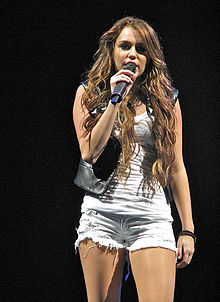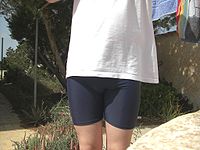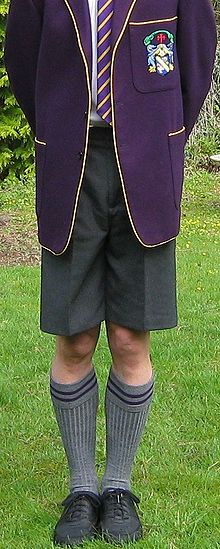- Shorts
-
This article is about a type of clothing. For another type of clothing, see cut-off. For other uses, see Shorts (disambiguation). For more uses, see Cutoff (disambiguation)."Hot pants" redirects here. For the James Brown song, see Hot Pants (song)."Jorts" redirects here. For the basketball player nicknamed "Jorts", see Josh Harrellson.
 David and Julie Eisenhower wearing shorts as they fish in Florida, 1971.
David and Julie Eisenhower wearing shorts as they fish in Florida, 1971.
Shorts are a bifurcated garment worn by both men and women over their pelvic area, circling the waist, and covering the upper part of the legs, sometimes extending down to or even below the knee, but not covering the entire length of the leg. They are called "shorts" because they are a shortened version of trousers, which cover the entire leg. Shorts are typically worn in warm weather or in an environment where comfort and airflow are more important than the protection of the legs.
Contents
Transatlantic terminological confusions
In British English the term "short trousers" is used, but only for shorts that are a short version of real trousers, e.g. tailored shorts, often lined, as typically worn as part of school uniform for boys up to their early-to-middle teens from roughly 1920 to 1980 (and still in Australia, Singapore, New Zealand and South Africa), and by servicemen and policemen posted overseas to tropical climates. The American-English term "short pants" is probably the nearest equivalent. In the US, these might nowadays be called "dress shorts" or "walk shorts", terms which have not gained currency in Britain. A somewhat similar garment worn by men in Australia is called "stubbies". "Shorts" is used unqualified in British English to refer to sports shorts, athletic shorts, or casual shorts, the latter nowadays being, in the United Kingdom itself, commonplace in warm weather.
The term "boxer shorts" was an American coinage for a particular kind of men's underwear, and is now common in Britain. However, boxer shorts are often referred to as "boxers" or "boxer briefs" in the USA. The word "pants" refers to outerwear (= trousers) in American usage (except when modified into "underpants") but when used unqualified in British English usually means underwear.
Sociology
Europe and the United States
In much of Europe and the United States during the 19th and early 20th centuries shorts were worn as outerwear only by young boys until they reached a certain height or maturity. When boys got older, typically around puberty, they would receive their first pair of long trousers. This produced the perception that shorts were only for young boys. Because of this, men would not wear shorts to avoid looking immature. Women tended not to wear shorts in most cultures, due to social mores.
In the 1890s, knee pants (an early type of short pants) became the standard wear for American boys. Many urban school portraits from the 1890s show all but the oldest boys wearing knee pants.[1]
American boys normally wore knee pants with short stockings.[2] This began to change after the 1900s when American boys began wearing knickerbockers, while short pants became more popular in Europe.
In the 1930s, shorts started to be worn for casual comfort (e.g. outdoor and athletic activities) by both men and women. However, it was still taboo to wear shorts outside certain activities.
Since about World War II, when soldiers often served in tropical locations, adult men have worn shorts more often, especially in summer weather, but the perception of shorts as being only for young boys took several decades to change and to some extent still exists in certain circles. By the late 20th century however it became common for men to wear shorts as casual wear in summer.
However, in many countries there are few formal settings where wearing shorts would be acceptable, as they are considered casual wear. Notable exceptions where men may wear short trousers to the office or at a formal gathering are South Africa, Bermuda, Australia and New Zealand.
Since the 1990s, casual office dress has grown in some UK and U.S. businesses, but by no means universally, to include formal shorts. Gym and denim shorts are still seen as too casual for office attire.
Worldwide
Boys in most countries wear shorts almost every day in the summer. Adult males are also commonly seen wearing shorts. Shorts are not common in the winter in certain regions, as it is too cold for part of the leg to be exposed.
Wearing shorts is less common among women in traditional eastern countries than in the West, but this varies widely by region - women more often wear shorts in large, cosmopolitan cities. In some countries adult women can be seen wearing loose-fitting shorts that end at or just below the knee, as these are seen as sufficiently modest. Above-the knee shorts are more often seen on pre-pubescent girls.
Styles
- Baggies
- Loose-fitting shorts which reach the knees. These were the standard shorts worn by English football teams before World War II. West Bromwich Albion FC are nicknamed the Baggies because their team used to wear particularly baggy shorts. Recently, baggy shorts have become once again the norm in football teams worldwide, after a period from about 1970 to 1990 when football shorts were extremely short.
- Approximately knee-length short trousers commonly worn in Bermuda (with long socks and a blazer and tie) for business attire and even at cocktail parties.[3] The style has also been adopted as a casual style in other locales. Usually has pockets and waist loops for an optional belt.
- Board shorts
- A combination of shorts and a bathing suit that reach the knee or below, typically worn by men, which have recently gained in popularity. Board shorts are manufactured by such companies as Billabong, Quiksilver, and Old Navy, originally intended as beachwear. The "board" refers to surfers' surfboards although many others also wear them. In the 1980s, board shorts were called "jams".
- Mainly used as male underwear. Some years ago, this term also related to a basic style male short.
- In the US, Similar to boxer briefs, but for females.
- Bun huggers
- Short, tight, athletic shorts also known as "racing briefs", commonly made from spandex and/or nylon. It is claimed that their tight fit and the fact that they barely go down past the buttocks give wearers an unhindered range of motion that is necessary in sports such as volleyball. However, the figure-hugging nature of these shorts makes some wearers feel uncomfortable, and making them compulsory for women athletes has been described as "venturing into the arena of athlete exploitation".[4] Bun huggers for men also exist. These resemble boxer briefs.
- Cargo shorts
- Typically khaki shorts with cargo pockets. Similar to cargo pants, but a little below knee-length. Cargo shorts consist of a garment with more than four pockets; and or pockets that are stitched to the outside of the fabric. Placement of pockets can vary but are most often seen on the lower part or side part of the short. Cargo shorts are distinctive because the pockets are accompanied by an overlying flap. Because of their casual appearance, they are prohibited at some golf courses and restaurants.
- Chubbies
- Radical short shorts for men. Traditionally worn in the 2000's for their comfort, radical stylings, and ability to attract the opposite sex. Often accompanied by sweet hawaiian shirts, tank tops, margaritas and barbecues.
- A divided skirt resembling a pair of loose-cut shorts, originally popularized as a practical horse and bicycle-riding garment by dress reform feminists at the turn of the 20th century. School uniforms have adopted culottes in more recent years as a more practical option than skirts.
- Cut-offs or Daisy Dukes
- Home-made by cutting the legs off trousers, typically jeans (known as "denim cut-offs"), above the knee. These were particularly popular in the early 1970s. The cut is not finished or hemmed and the fabric is left to fray. They became so popular that they were sold in stores as such. Originally a practical use for trousers with worn-through knees, they are now a type of shorts in their own right. The ultra-short version of jean cut-offs are also known as Daisy Dukes, in reference to Catherine Bach's character of that name from the American television show The Dukes of Hazzard. They are a form of hot-pants or short shorts. The character Tobias Fünke from the television series Arrested Development is also known for wearing cut-off jeans as an undergarment.
- Skin-tight long shorts originally worn by cyclists to reduce chafing while cycling, but which have also been adapted and adopted as street wear, active wear and is often worn under skirts and dresses for modesty reasons. Also commonly known as "bike shorts".
- Denim shorts
- Denim shorts are worn by both genders. For males, they are generally looser and longer.
- An athletic style of shorts, notable for visible binding of an often contrasting color. The name may refer to a side-view of the binding of each leg's lower hem, resembling the shape of a dolphin tail. Like gym shorts, they often feature a cord to be tied around the waist at the front. These were a popular trend in the 1980s gym scene.
- Gym shorts are often worn in gym class or for participation in sports, hence the name, but they are worn as casual wear almost as much, especially by adolescents. They are usually not form-fitting when worn by men or female athletes, but are often form-fitting when worn by women as casual dress. Length is usually from just above the knee to just below the knee. In the 1970s and 1980s in the U.S. gym shorts were often form-fitting and only slightly longer than boxer shorts. Gym shorts are generally made of cotton, spandex, polyester, or another synthetic fiber with a cord sewn in that can be tied at the front to tighten the waist.
- Hot pants
 Singer Miley Cyrus wearing a pair of jorts.
Singer Miley Cyrus wearing a pair of jorts.
- Categorized as "short shorts", they commonly have an inseam length of 2 inches (50 mm) or less. These are short, tight shorts, usually made of cotton, nylon, or some other common material. They are meant to emphasize the buttocks and the legs.
Launched by fashion designer Mary Quant during the "Swinging London" scene of the mid 1960s,[5] hot pants were very popular up to the early 1970s.
- Jorts
- Jean shorts.
- Traditional German leather shorts.
- Leather shorts
- Shorts made from leather.
- Plaid shorts
- Usually made of Madras, fabricated woven of differently colored yarns in a crossbarred pattern. Popularized by "skater" stores, but now becoming more "preppy".
- Reach only the upper thigh; intended to provide maximum freedom of movement in sports activities. These are often made from Nylon, which has the advantage of being very hardwearing. After Adidas sponsored the 1980 Olympic Games,[6] Adidas nylon track shorts were a fashion item for some years.
- Short shorts
- By the mid-1950s, post-WWII Americans were beginning to relax and enjoy both their new economic and baby booms as their offspring which were just entering their teens. Television and rock'n'roll captured taste and fashion, including the new "short shorts" fad, since Bermuda shorts were considered old, dull, and "fuddy-duddy" although, as History of Costume[7] author and FIT Professor Rachel Kemper noted, "Short shorts left a girl's ass hanging out."[8] The Royal Teens wrote and sang the song "Short Shorts" (1957) (in which "short shorts" is mentioned 18 times). That song was itself referred to in Sheb Wooley's song "Purple People Eater" song (1958).[9] Short shorts also refers to the older style of tight basketball shorts which went upper-thigh worn by players until the 1990s, when looser shorts that went down to the knee became the norm. Many clothing vendors refer to 'short shorts' as having an inseam of four inches or less.
- Short trousers (British English) or school shorts
- These are fully tailored and usually lined shorts with full zip fly and belt loops, in former times of flannel, nowadays of a cotton/synthetic mixture, typically in grey, worn by male primary and secondary school students as part of a formal school uniform in Britain, Australia, Singapore, South Africa and New Zealand, and also by Cub scouts. These were typically worn with long socks, or stockings (as they were known till 1960s) often also grey and often with coloured tops. They nowadays mostly reach down to the knee or even slightly further; from about 1960 until the 1980s they were generally much shorter, typically coming to about half way up the thigh when standing. In tailoring/menswear trade jargon (and colonial English) they are sometimes misleadingly called "knickers". Use of the word "knickers" reminds us that "shorts" for boys descended from "knickerbockers" which were commonly worn by boys in UK before the 1920s. Knickerbockers fell below the knee and were attached by buttons to stockings. In the 1920s knickerbockers gradually became shorter and lost their attachment to the stockings leaving the knee bare. Eventually, in effect, the knickerbockers turned into shorts and the stockings turned into turn-over knee stockings with coloured tops (after 1960s increasingly called knee-socks). Hence the new "shorts" were in the 1920s and 1930s (and even later) occasionally called "knickers" by old-fashioned outfitters. Some shorts even retained vestigial buttons reminding us that knickerbockers had been "buttoned" to stockings. [Knee pants with buttons at the knee hem appeared in the mid-19th century. We have never noted these buttons being used to hold up stockings. They seem to be a vestigial remnants of 18th century breeches. The 19th and early-20th century century were straight-leg knee pants. They were worn with long stockings, but the buttons had nothing to do with holding up the long stockings. Rather a wide variety of stocking supporters were worn by children to hold up the stockings.] But this name, "knickers" was never used among the ordinary public and least of all among schoolboys themselves, since "knickers" in British English had gradually come to refer to a kind of women's underwear and used to be regarded as a somewhat rude word.
- Have a piece of fabric in front, creating the illusion of being a skirt from the front. The term is a portmanteau of "skirt" and "shorts".
- Slackettes
- A term coined in the late 20th century by the fashion cognoscenti of the New York City neighborhood of Nolita (Northern Little Italy) as an alternative to the more frequently used term "shorts", referring to clothing worn around the waist and having two legs extending no further than mid-knee. This term quickly spread to the fashionista residents of New York's Chelsea gallery neighborhood and, by the early years of the 21st century, had worked its way into the everyday parlance of the community of fashion-savvy Manhattan residents.[10]
- Three quarter pants (Or Flood Pants)
- A name used to refer to pants such as Shants or Shankles which go down to the calf and are arguably not long shorts but short longs.
- Zip-off Shorts or Convertible Shorts
- A pair of long pants that zip off at the knee, allowing the wearer to change from pants to shorts as the weather changes. Originally a hiking garment, these have become a more casual fashion item since the late 1990s.
- Yimps
- Very short men's shorts designed to have a vintage, mid-century look.
Changing styles
By 2000, men and boys had begun to wear longer shorts that reached below the knee. These sometimes extend even as far as the calf, as in three quarter pants, making it debatable whether to call them "long shorts" or "short longs". They were popular among young boys and teenagers. A decade later in 2010, many young boys and teens still wear these longer shorts that reach several inches below the knee.[citation needed] However, the long shorts trend has recently started to reverse itself, and most teenage boys now prefer shorts that stop at the knee or just above.[11]
References
- ^ U.S. School Clothes: Individual Schools--The 1890s at Boys' Historical Clothing School Uniform Pages.
- ^ United States Boys Garments: Pants--Knee Pants at Boys' Historical Clothing School Uniform Pages.
- ^ Bermuda Shorts: Local spring to fall male business attire and female smart casuals at Bermuda-Online.
- ^ "Bun Huggers: To Wear or Not to Wear", Women's Sports Foundation.
- ^ Ros Horton, Sally Simmons, 2007. Women Who Changed the World
- ^ Games of the XXII Olympiad, Moscow. 1980.
- ^ Kemper, Rachel (December 1977). History of Costume. New York: W W Norton & Co. ISBN 978-0882251370. http://www.amazon.com/dp/0882251376.
- ^ Kemper, Rachel H. (1977). Costume. New York: Newsweek Books. ISBN 0882251376. http://www.amazon.com/History-Costume-culture-Rachel-Kemper/dp/0882251376/ref=sr_1_2?ie=UTF8&s=books&qid=1235776362&sr=1-2.
- ^ "Short shorts" at the Bad Fads Museum.
- ^ Sharma, Satish K., "Style Debate: Give Shorts A Leg Up", Times of India, 14 October 2008.
- ^ Shorts For Boys: Spring and Summer 2010 at About.com: Kids' Fashion.
External links
Categories:- Trousers and shorts
- History of fashion
Wikimedia Foundation. 2010.


